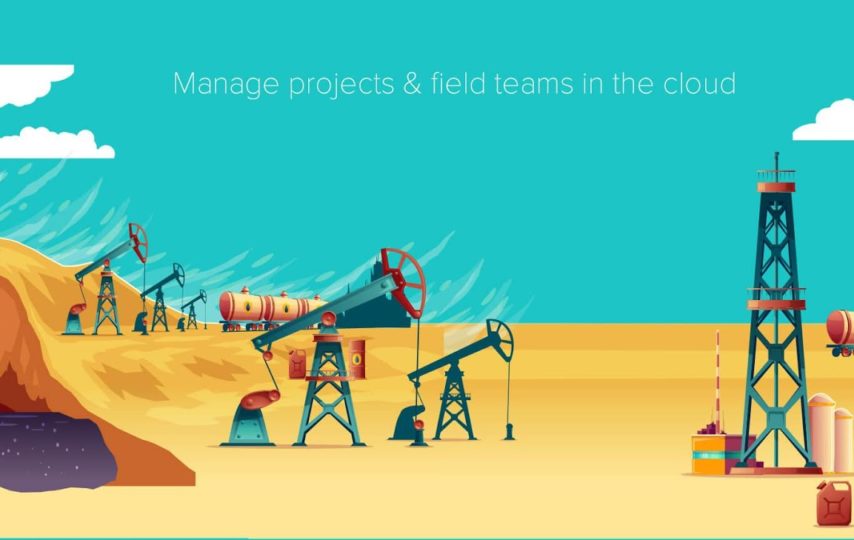Oil and gas companies cannot afford the smallest of delays in the projects as it can cost millions of dollars’ worth of loss. The necessity to be scalable has now become more important than ever as oil and gas projects increase in volume and size. When they are dependent on a manual process or decentralized spreadsheets, there is a high chance that the project may be at risk, and extended hours will be required to solve any issues manually. Hence, accurate forecasting and effective progress reports are the current requirements for all Oil and Gas companies, which is why they are now making use of project management software for accurate data on the projects in real-time. This way, the focus is more on data analysis rather than data entry.
A great number of oil and gas companies are utilizing digital technologies in order to increase productivity, efficiency, predictability, and reliability of operations. It has become a major challenge in this sector today to manage the complexity of projects, with stakeholders demanding reduced risk, higher return on investment, and greater transparency. Since the schedules and budget is tight, safety is a crucial factor in the environment and the communities. Oil and gas project management software must deal with large and complex projects.
What is Oil and Gas project management software?
Oil and gas project management software is different in comparison to general project management software. They have special characteristics that require a different approach to management. This is mainly so because countries depend on the development of energy reserves for economic growth. This is possible by investing in various oil and gas projects by exploring onshore and offshore drilling and increasing the capacity of facilities. Hence, project management software for oil project management or gas project management needs to be at par with the requirements of the industry, for owners as well as contractors and engineers.
Especially cloud-based oil and gas project management software is the need of the hour as reliability, safety, and security of documents are crucial for this industry. Oil and gas project management software also provides accurate data analysis, unlike spreadsheets, that are outdated.
Ways to improve project delivery
- Embrace project production management
Though currently, the oil and gas project management approach focus mainly on detailed planning, these companies would benefit by adopting project production management , in which each project is viewed as a group of different production systems with different processes for each set. This way, it becomes an easy task to optimize performance by giving project managers the authority to control the overall project-production. They will be able to adjust capacity and response time to deal with unpredictability in demand or supply. Oil and gas companies mainly need to focus on flow efficiency during on-site construction. This maximizes output and reduces the amount of work in progress.
- Fully digital project
Technology has great potential to improve the processes that are used in oil and gas projects. It is used with automated engineering processes and five-dimensional building-information modeling, which is also called 5-D BIM. This eliminates the execution of repetitive tasks manually and reduces the input requirements for contract management, thereby making it easier to automate quality-control functions. Automating these processes can bring down the requirement of manual work and increase transparency. Cloud-based project management software can reduce the risk of data loss. However, it is not used much in oil and gas project management. These technologies are expected to be implemented in the near future.
- Utilize advanced analytics
Data is a major necessity for oil and gas project management teams. This data can be used to gauge performance and how it can be made better while improving project quality. Data produced can improve monitoring of supplier performance, workforce management, and predictive site scheduling. However, oil and gas project management teams hardly ever make complete use of the data that is made available to them. The reason for this is that this data exists in electronic spreadsheets that have no central repository, and the capturing of data is not standard. Moreover, project reporting is done in different systems, styles, and formats, making it quite unreliable.
- Adopt an Agile framework
The Agile framework has been in use for a long time; however, it has recently been adopted by the oil and gas companies. The Agile framework consists of small teams that are exceptionally coordinated to encourage rapid learning and decision cycles. It works towards making key decisions faster, enabling the company that adopts it to respond to the competitive environment quickly. In oil and gas companies, Agile organizes small teams that report to the product owner who has an idea of what the project should look like. He, then analyzes the time required to complete the work and how it can be achieved by outlining a roadmap. The teams then work according to this road map to achieve set objectives.
Top Five Oil and Gas Project Management Software
1. PlanStreet
The oil and gas industry is extensively progressive, and deciding where to invest your resources is crucial. With the help of PlanStreet, project managers can find out the accurate logging time, budget forecasting, and tracking to maximize the profit margin, reputation, and leverage for the companies. PlanStreet has a project portfolio management tool that aims at improving your team’s performance and profitability. You can shuffle between multiple projects to get a view of the big picture and understand what is happening in every project that you handle.
Project managers can also track costs in real-time by using timesheets and work logs. Stakeholders today want transparency, and PlanStreet creates it to the maximum. Moreover, it is cloud-based software, which means your data is always safe and secure. PlanStreet provides a free demo so you can see how it works before making a purchase.
2. Earthway 4D Suite
Earthway 4D suite provides a 4-dimensional view of where rocks are and what they look like, or where oil is located underground with the help of tools like Underground 4D. It provides a visual representation of reports like material breakdowns, depth brackets, and pricing counts. The software was specially designed to be a custom fit that provides accuracy, speed, and ease of use for earthwork to take-off. It has powerful modeling features that make site work solutions easy to implement. Earthway 4D suite can also help you win bids with the information it provides you with in detail. You can also use this information on your smartphone.
3. ARES Prism
ARES PRISM provides a solution for at-scale implementation that can be complex in oil and gas environments. This is so because they are capital-intensive, and a large number of challenges arise regarding legacy equipment. Oil and gas companies regularly face issues like increasingly complex projects, lack of change management, limited transparency, lack of accuracy, and time-consuming month-end reports. This software provides a solution for project controls, as well as project management. ARES Prism has been used by leading oil and gas companies for efficient project management throughout all stages of the project lifecycle. ARES Prism has been around for more than 20 years.
4. ProjecTools
ProjecTools is a web-based platform pertaining to engineering and commissioning. It enables processes such as planning, execution, and tracking of complex activities related to oil and gas projects. It has a cloud-based system that helps global teams, including engineers, managers, completion admins, and inspectors. The software ensures that milestones and inspections are completed in order with the help of progression dependencies. Project managers can update the right tag data in ITRs within seconds and auto-populate them. ProjecTools integrates with document managers that allow inspectors to find technical and engineering documents easily. It also has an OCR technology that is aimed at automating the logging of completed sheets in the system.
5. FieldFX
FieldFX enables project managers to connect from the field to the office regardless of where they are, without the presence of an internet connection. It is designed to streamline communication between field operations, office management, and accounting at the touch of a button. The software is scalable, flexible, and allows changes to be made at the touch of a button. For the oil and gas industries, FieldFX helps in handling account management and keeping up with the changes in price. Moreover, it is customized based on your industry and needs that can be implemented on an individual basis.
The Bottomline
Oil and Gas companies that make use of oil and gas project management software can reduce costs, complete construction projects faster, and improve predictability. Companies need to envision actions that enable the deployment of new solutions. Though traditional methods are still followed in oil and gas project management, the benefits of using technology and software must be taken into consideration regarding engineering practices, policies, information technology, and supply-chain management. Project managers and teams must incorporate new technologies, encourage collaboration, and build trust between product owners, project managers, and their teams. This will be a critical component in the future for this sector.








